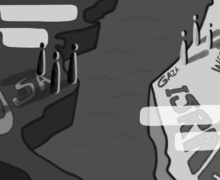Syracuse improves rebounding in 68-54 loss to Iowa
Elizabeth Billman | Asst. Photo Editor
Junior forward Marek Dolezaj scored his first three-pointer of the season.
Elijah Hughes sat in the middle of the Syracuse locker room with his right wrist taped. Bourama Sidibe, in his own locker a few feet away, had bags of ice attached to his right knee and left ankle. Perpendicular to both of them was Marek Dolezaj, shoulders off-kilter, slouching to his left with his right shoulder wrapped.
As they scattered, with a similar dejected look on their faces after a third-straight defeat, they wore the scars of a rebounding battle, that, for once, didn’t cost Syracuse the contest.
“I think we did quite a decent job today,” Dolezaj said, “but we need to run faster.”
Facing a third-straight frontcourt that’s bigger and more polished than SU’s, Syracuse improved on the glass. In the midst of a historically bad start, SU’s first three losses could be attributed to poor interior play. They averaged 18 fewer rebounds than their opponents, often losing the possession battle too. But, against Iowa (6-2) in the ACC-Big Ten Challenge on ESPN, Syracuse (4-4, 0-1 Atlantic Coast) provided an outlier. Coaches provided a pregame directive to limit the rebounding margin. While the Hawkeyes won the battle on the glass 37-36, they had to turn to shooting or tough defense to best the Orange.
Syracuse may have wasted its last chance at a resume-boosting, nonconference win with its showing against Iowa, but the corrected rebounding provided a sliver of positivity. Without worrying about about the interior, SU was able to identify other issues that the reeling squad must fix next.
Iowa’s 6-foot-11, do-everything player, Luka Garza provided one of the worst matchups of the season for Syracuse. A week ago, Oklahoma State crushed the Orange with a plus-19 rebounding margin. Two days later, Penn State’s Mike Watkins tallied 16 boards, 11 of which were offensive. PSU’s 57-to-28 rebounding lead triggered Boeheim to admit that his team “wasn’t ready,” as two tournament-caliber teams exposed SU. Before facing Garza, Sidibe and Hughes said Orange coaches emphasized rebounding at all costs.

Elizabeth Billman | Asst. Photo Editor
There wasn’t a schematic change. Instead, players were urged to get to the boards more often.
As Garza looked for early offense inside, Dolezaj bumped him off the block each trip down the floor before settling into the 2-3. SU’s 2-3 zone isn’t predicated on matchup box outs, Sidibe said, so it wasn’t Sidibe or Dolezaj’s single responsibility to stop Garza. The Iowa junior finished with 23 points, nine rebounds and two assists, yet the Orange limited second chances (15-to-eight in Iowa’s favor). Syracuse even scored more points in the paint (26-to-24).
“Sometimes it’s a long rebound,” Sidibe said. “We just need to find a way to get it. It’s a zone.”
Hughes, who posted a season-high seven boards, skied through the lane repeatedly, often while teammates cleared out Hawkeyes. In one sequence, Hughes hauled in a board and quickly fed Quincy Guerrier for a two-handed slam. This success wasn’t consistent.
“There’s a lot of bad out there,” SU head coach Jim Boeheim said, “I didn’t see much good.”
Sidibe operated at “half-speed” with his cold in Brooklyn, Boeheim said, and was limited today, too. Hughes rebounded more, but he wasn’t as effective as a facilitator, finishing with four turnovers. Guerrier followed his first collegiate double-double with four points and seven boards, but Boeheim identified situations where the strongest player on SU’s roster wasn’t strong enough.
With a middling offense hunting for a secondary option behind Hughes, fast break chances can piece together points and runs. The Hughes-Guerrier connection showed what the offense could be but ultimately hasn’t been. And it starts with rebounding.
“It’s a learning experience for those guys,” Boeheim said. “They’ve got a long way to go.”
Published on December 3, 2019 at 11:16 pm
Contact Nick: nialvare@syr.edu | @nick_a_alvarez





